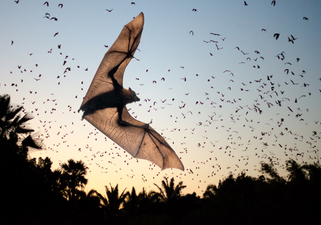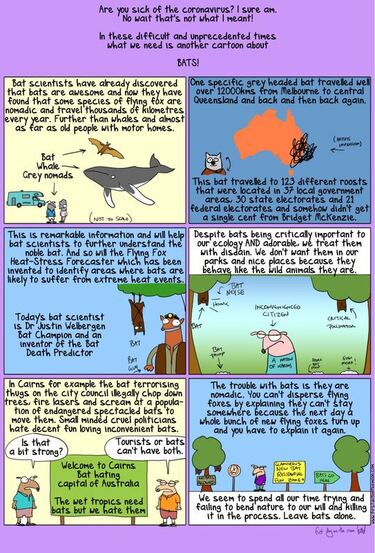Flying-fox movement ecology
|
How and why animals move across the planet has fascinated humankind since time immemorial. However, until recently, progress in movement research has been slow due to technological limitations and a lack of consistent methodology. Current research focuses on understanding the underlying causes of movement patterns and their ecological and evolutionary consequences. Such studies are key for our fundamental understanding of animal movement as well as for managing our biodiversity under anthropogenic environmental change.
Flying-foxes are charismatic bats found across the Old World and Australia. They are the most mobile mammals on earth by most measures, and ideal models for studying movement across a wide range of spatiotemporal scales. Flying-fox movements range from small relocations within colonies and foraging sites, to nightly foraging trips of up to 80 km, to long-distance nomadism covering thousands of kilometres across up to 16 degrees of latitude in a single year.
Their extreme mobility makes flying-foxes key long-distance pollen and seed dispersers in Australia’s fragmented forest ecosystems, and enables their successful exploitation of the unpredictable resource environment of this country. However, their mobility also facilitates transmission of disease and often brings them in conflict with humans, and so they require a precarious balancing of conservation and management concern.
Understanding how and why flying-foxes move across different spatiotemporal scales is crucial for the management of the species, the habitats in which they live, and the trajectory of new emerging diseases. Recent advances in tracking technology and remote-sensing, makes it possible - for the first time - to investigate movement from local to continental scales in a single animal system.
|
Nomadic movements of two adult female grey-headed flying-foxes, tracked over a period of five years (Welbergen et al. 2020).
|
Aims & Objectives
THIS RESEARCH IS TO DEVELOP A MECHANISTIC UNDERSTANDING OF THE MOVEMENT ECOLOGY OF FLYING-FOXES, FROM LOCAL TO CONTINENTAL SCALES.
|
To make this ambitious aim tractable, our research program will focus on the following two areas of research:
With this project we address key issues in the field of movement research, and provide much-needed scientific underpinnings for policy and management of Australia's flying-foxes and other mobile species. Our approach is guided by the emerging paradigm of ‘movement ecology’ that focuses on identifying behaviour from tracking data and revealing the mechanisms that drive patterns of movement.
Our methodology involves innovative experimental manipulation, designed to determine how flying-foxes navigate, and data from cutting edge GPS/biotelemetry technology, satellite telemetry, and Doppler radar. Combined with the latest analytical techniques, these will enable us to determine the intrinsic (i.e. physiological) and environmental factors that govern flying-fox movements. We are in the unique position that we already have at our disposal the biotelemetry technology, and the extensive GPS, satellite and Doppler radar data required to successfully complete this project. |
Fabulously insightful overview of our lab's work by The Guardian's First Dog on the Moon!
|
Research Team
Our Research Program brings together a multi-institutional team comprising the following people:
- Prof Justin Welbergen - Hawkesbury Institute for the Environment (Western Sydney University)
- A/Prof Christopher Turbill - Hawkesbury Institute for the Environment (Western Sydney University)
- Dr Jessica Meade - Hawkesbury Institute for the Environment (Western Sydney University)
- Dr David Westcott - CSIRO
- Adam McKeown - CSIRO
- Dr John Martin - Taronga Conservation Society Australia
Funding
Assessing the roosting and foraging habitat use of the grey-headed flying-fox before vs after Australia's 2019-20 megafires
Chief Investigators: Prof Justin Welbergen & Dr Jessica Meade
Partner Investigator: Dr John Martin
Funding Body: Australia's Regional Bushfire Recovery for Multiregional Species and Strategic Projects Program (MSSPI000009)
Period: 2021-present
Chief Investigators: Prof Justin Welbergen & Dr Jessica Meade
Partner Investigator: Dr John Martin
Funding Body: Australia's Regional Bushfire Recovery for Multiregional Species and Strategic Projects Program (MSSPI000009)
Period: 2021-present
Movement ecology of flying-foxes - integrating mechanisms and patterns across multiple spatiotemporal scales
Chief Investigators: Prof Justin Welbergen & A/Prof Christopher Turbill
Partner Investigator: Dr David Westcott
Named PDRA: Dr Jessica Meade
Funding Body: ARC DISCOVERY (DP170104272)
Period: 2017-2023
Chief Investigators: Prof Justin Welbergen & A/Prof Christopher Turbill
Partner Investigator: Dr David Westcott
Named PDRA: Dr Jessica Meade
Funding Body: ARC DISCOVERY (DP170104272)
Period: 2017-2023
Student Projects
- Ram Mohan - PhD Candidate (Western Sydney University; supervisors: Prof Justin Welbergen, Dr Jessica Meade) Topic: A cross-continental comparison of drivers of flying-fox urbanisation
- Sienna Grady - PhD Candidate (University of Western Sydney); supervisors: Prof Justin Welbergen, Dr Jessica Meade, Prof Matthias Boer. Topic: Monitoring the spatiotemporal dynamics of nectar availability for flying-foxes across eastern Australia
Completed student projects
- Melissa Walker - PhD Candidate (Western Sydney University; supervisors: Dr Christopher Turbill, Dr Jessica Meade, Prof Justin Welbergen). Topic: Flying-fox phyisology and energetics
- Eliane McCarthy - MRes student (University of Western Sydney; supervisors: Prof Justin Welbergen, Dr John Martin, Prof Matthias Boer. Topic: Remote sensing of Australian flying-fox camps.
- Samantha Yabsley - MRes student (University of Western Sydney; supervisors: Prof Justin Welbergen, Dr Jessica Meade. Topic: Drivers of flying-fox urbanisation
References
- YABSLEY, S. H., MEADE, J., HIBBURT, T., MARTIN, J. M., BOARDMAN, W. S. J., NICOLLE, D., WALKER, M., TURBILL, C & WELBERGEN, J. A. (2022). Variety is the spice of life: flying-foxes exploit a variety of native and exotic food plants in an urban landscape mosaic. Frontiers in Ecology and Evolution, 10:907966
- MCCARTHY, E. D., MARTIN, J. M., BOER, M. M. & WELBERGEN (2022). Ground-based counting methods underestimate true numbers of a threatened colonial mammal: an evaluation using drone-based thermal surveys as a reference. Wildlife Research, doi: 10.1071/WR21120
- TODD, C. M., WESTCOTT, D.A., MARTIN, J. M., ROSE, K., MCKEOWN, A., HALL, J & WELBERGEN, J.A. (2022). Body-size dependent foraging strategies in the Christmas Island flying-fox: implications for seed and pollen dispersal within a threatened island ecosystem. Movement Ecology, 10:19
- YABSLEY, S. H., MEADE, J., MARTIN, J. M., & WELBERGEN, J. A. (2021). Human-modified landscapes provide key foraging areas for a threatened flying mammal: The grey-headed flying-fox. Plos One, 16: e0259395
- MEADE, J., MARTIN, J. M., & WELBERGEN, J. A. (2021). Fast food in the city? Nomadic flying-foxes commute less and hang around for longer in urban areas. Behavioral Ecology, 32: 1151-1162
- MCCARTHY, E. D., MARTIN, J. M., BOER, M. M. & WELBERGEN (2021). Drone-based thermal remote sensing provides an effective new tool for monitoring the abundance of roosting fruit bats. Remote Sensing in Ecology and Conservation, 7: 461-474
- WELBERGEN, J. A., MEADE, J., FIELD, H., EDSON, D., McMICHAEL, L., SHOO, L. P., PRASZCZALEK, J., SMITH, C., MARTIN, J. (2020) Extreme mobility of the world's largest flying mammals creates key challenges for management and conservation BMC Biology, 18:101
- MEADE, J., VAN DER REE, R., STEPANIAN, P. M., WESTCOTT, D. A. & WELBERGEN, J. A., 2019. Using weather radar to monitor the number, timing and directions of flying-foxes emerging from their roosts. Scientific Reports, 9(1), p.10222.
- WESTCOTT, D. A., MCKEOWN, A., PARRY, H., PARSONS, J., JURDAK, R., KUSY, B., SOMMER, P., ZHAO, K., DOBBIE, M., HEERSINK, D., CALEY, D. 2015. Implementation of the national flying-fox monitoring program (Rural Industries Research and Development Corporation, Canberra, 2015).
- JURDAK, R., SOMMER, P., KUSY, B., KOTTEGE, N., CROSSMAN, C., MCKEOWN, A. AND WESTCOTT, D., 2013, April. Camazotz: multimodal activity-based GPS sampling. In Proceedings of the 12th international conference on Information processing in sensor networks (pp. 67-78). ACM.
- WELBERGEN, J. A., KLOSE, S. M., MARKUS, N. & EBY, P. (2008) Climate change and the effects of temperature extremes on Australian flying-foxes. Proceedings of the Royal Society of London, Series B 275, 419-425
- BIRO, D., FREEMAN, R., MEADE, J., ROBERTS, S., & GUILFORD, T. (2007). Pigeons combine compass and landmark guidance in familiar route navigation. Proceedings of the National Academy of Sciences, 104(18), 7471-7476
- WELBERGEN, J. A. (2006) Timing of the evening emergence from day roosts of the grey-headed flying-fox, Pteropus poliocephalus: the effects of predation risk, foraging needs, and social context. Behavioral Ecology and Sociobiology, 60: 311-322
- MEADE, J., BIRO, D., & GUILFORD, T. (2005). Homing pigeons develop local route stereotypy. Proceedings of the Royal Society of London B: Biological Sciences, 272(1558), 17-23





